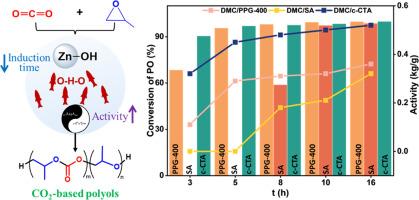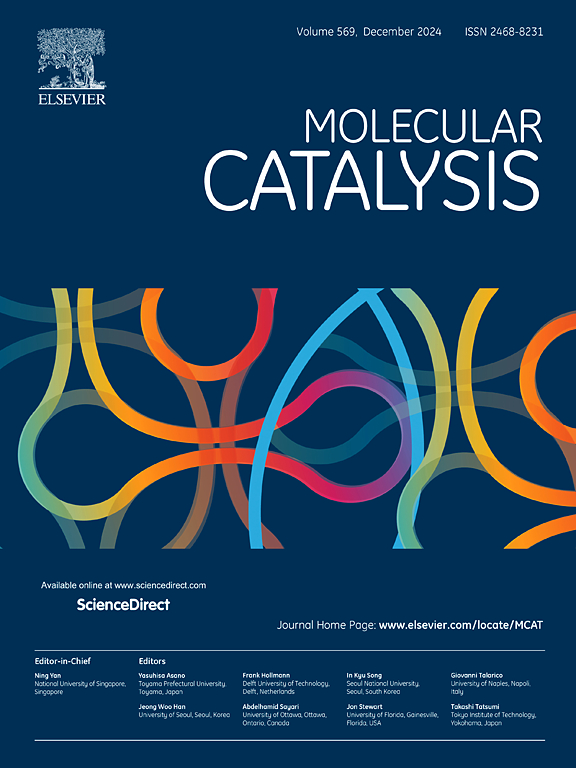Enhanced activity for producing CO2-based polyols enabled by Zn-Co DMC/c-CTA catalytic system
IF 4.9
2区 化学
Q2 CHEMISTRY, PHYSICAL
引用次数: 0
Abstract
CO2-based polyols have a unique terminal hydroxyl group structure that makes them suitable for the production of high-performance polyurethane foams. Zn-Co double metal cyanides (DMC) are an important class of catalysts for the copolymerization reaction of CO2 with propylene oxide (PO). In the DMC-catalyzed CO2/PO copolymerization to produce CO2-based polyols, the crucial role of chain transfer agents (CTAs) is emphasized. In this work, a high-performance composite CTA (c-CTA) was successfully developed by investigating various dicarboxylic acids and polypropylene glycol (PPG-400) as CTAs. This system combines the high reaction rate of the DMC/PPG-400 system with the high CO2 insertion rate of the DMC/sebacic acid (SA) system, achieving 2-3 times higher activity than that of single CTA (PPG-400 or SA), reaching 0.5 kg/g. The molecular characteristics of the CO2-based polyols synthesized by different DMC/CTAs systems were analyzed by FTIR and 1H NMR. The reasons for the high catalytic activity of the DMC/c-CTA system were elucidated by analyzing the hydrogen bond distribution in each DMC/CTA systems. Overall, this work provides a theoretical guidance for the development of novel CO2-based materials with high industrial application value.

利用 Zn-Co DMC/c-CTA 催化系统提高生产二氧化碳基多元醇的活性
二氧化碳基多元醇具有独特的末端羟基结构,因此适用于生产高性能聚氨酯泡沫。Zn-Co 双金属氰化物(DMC)是二氧化碳与环氧丙烷(PO)共聚反应的一类重要催化剂。在 DMC 催化 CO2/PO 共聚生成二氧化碳基多元醇的过程中,链转移剂 (CTA) 的关键作用受到重视。在这项工作中,通过研究各种二羧酸和聚丙二醇(PPG-400)作为 CTA,成功开发了一种高性能复合 CTA(c-CTA)。该体系结合了 DMC/PPG-400 体系的高反应速率和 DMC/ Sebacic acid(SA)体系的高二氧化碳插入速率,其活性是单一 CTA(PPG-400 或 SA)的 2-3 倍,达到 0.5 kg/g。傅立叶变换红外光谱和 1H NMR 分析了不同 DMC/CTAs 系统合成的二氧化碳基多元醇的分子特征。通过分析各 DMC/CTA 系统中的氢键分布,阐明了 DMC/c-CTA 系统催化活性高的原因。总之,这项工作为开发具有较高工业应用价值的新型二氧化碳基材料提供了理论指导。
本文章由计算机程序翻译,如有差异,请以英文原文为准。
求助全文
约1分钟内获得全文
求助全文
来源期刊

Molecular Catalysis
Chemical Engineering-Process Chemistry and Technology
CiteScore
6.90
自引率
10.90%
发文量
700
审稿时长
40 days
期刊介绍:
Molecular Catalysis publishes full papers that are original, rigorous, and scholarly contributions examining the molecular and atomic aspects of catalytic activation and reaction mechanisms. The fields covered are:
Heterogeneous catalysis including immobilized molecular catalysts
Homogeneous catalysis including organocatalysis, organometallic catalysis and biocatalysis
Photo- and electrochemistry
Theoretical aspects of catalysis analyzed by computational methods
 求助内容:
求助内容: 应助结果提醒方式:
应助结果提醒方式:


